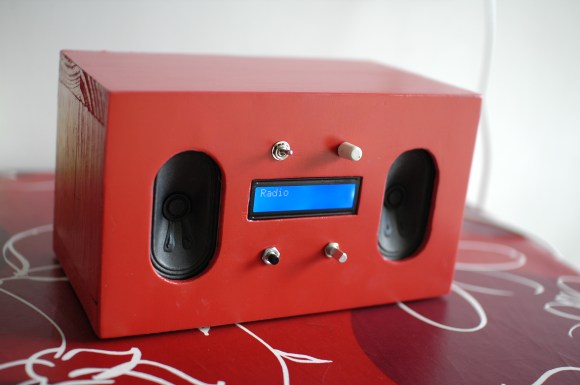
We like the look which [Emmanuel] achieved with his Raspberry Pi based Squeezebox client. It’s got that minimalist slant that makes it seem like a commercial product at first glance. But one more look at the speakers without grates, the character LCD, and the utilitarian buttons, knobs, and switches tips us off that it’s filled with the hardware we know and love.
Since Logitech announced that it was terminating the Squeezebox line we’ve seen several projects which take up the torch. We’ve seen the RPi used as a Squeezebox server and several embedded Linux systems used as clients. This follows in the footsteps of the latter. The RPi is running Raspbian with the squeezelite package handling the bits necessary to talk to his server. The controls on the front include a power switch, rotary encoder and button for navigating the menus, and a potentiometer to adjust the HD44780 LCD screen’s contrast. The speakers are a set of amplified PC speakers that were liberated from their cases and mounted inside of the wooden box that makes up the enclosure. The in-progress shots of that case look pretty rough, but some sanding and painting really pulled everything together. As you would expect, we’ve embedded the demo video after the jump.














Is he getting 16 bit audio out of it?
Oh this is good but I was dissapointed when I realised it wasn’t a small reedy musical instrument !
Seems that the software instructions are not quite right. See below
python squeezeberryUI_v1.py build
Traceback (most recent call last):
File “squeezeberryUI_v1.py”, line 23, in
import gaugette.rotary_encoder
ImportError: No module named gaugette.rotary_encoder
So then we try this python rotary_encoder.py build
Traceback (most recent call last):
File “rotary_encoder.py”, line 26, in
import wiringpi
File “/home/pi/wiringpi.py”, line 26, in
_wiringpi = swig_import_helper()
File “/home/pi/wiringpi.py”, line 18, in swig_import_helper
import _wiringpi
ImportError: No module named _wiringpi
So far I can not get past this even with wiringpi.py installed
Anybody keen keen to shed some light as this looks like a real nice project
So got a little further but now this error
sudo python squeezeberryUI_v1.py
Traceback (most recent call last):
File “squeezeberryUI_v1.py”, line 406, in
ui = UINavigation()
File “squeezeberryUI_v1.py”, line 236, in __init__
self.sbs = SqueezeBoxServer(host=”192.168.0.45″,port=9000, player_id=”80:1f:02:82:3a:50″)
File “squeezeberryUI_v1.py”, line 33, in __init__
self.artists = self.query( “artists”, 0, 9999)[‘artists_loop’]
KeyError: ‘artists_loop’
Hoe did you solve the ‘no module named wiringpi’ problem?
Even one bit is perfectly capable of playing a tune, with an infinitely low noise floor.
Those are nice finger grips on the front.
Eek naked speakers!
cool project but i dont see the point re: crappy sound quality via those cheap ass drivers.
Audiophiles may not like to admit it, but most people are fine with quite low grade sound quality. Just look at the number of so-called stereo units that have the speakers a few centimetres apart-no chance of getting the stereo effect, but as long as the bass is strong no-one seems to mind. DAB radio in the uk sounds awful to me, but many people are happy to listen to it.
Still there’s a fair middle ground between solid gold speaker wire and the horrible crap you get in PC speakers. My PC drives a pair of 70 quid Mission 500s thru an old amp from the 80s. Sounds fantastic! I’ve always had a decent pair of speakers for the PC, and it’s the only music source I really have (except the phone). Has been since the mid-90s when MP3s got popular, a couple of years before Napster.
Speakers and hifi probably suffer diminishing returns more than sports cars. But it’s certainly worth spending a few extra quid, not even that much, to get some decent ones. The enclosure matters too, tho there’s a trade-off between size, loudness and quality relevant in a portable box.
Nowadays amp chips sound great and are cheap. The source is digital. So the speakers are gonna be responsible for most of the quality discernible in this build.
Intended as a table top “radio”, casual listening, not HiFi. For the intended purpose they’d have to exhibit some pretty serious buzzing or rattles for most to say enough, turn it off
Still there’s an audible difference you’d appreciate hearing. It’s like listening to music through earphones. You hear much more detail, sometimes even entire new instruments become clear.
There’s a place for kitchen radios, but this gadget looks useful enough to use quite a lot. Replacing the speakers wouldn’t be hard, if dude ever wants to. Failing that I suppose he could fit a line-out to the back and plug it into something better when he needs to.
agreed
you all forget the radio in question is a online stream that may occationally be low bitrate, high compression, both, and may even be variable depending on connection.
Actually you’ve misunderstood the possibilities with Squeezebox; while it’s true it can stream most Internet radio stations and there is a tunein plugin, it is almost better used streaming your own music from your own server. I use a Netgear ReadyNas to store all my media, the Squeezebox server can be run directly on the NAS, and can stream to the Squeezebox or Squeezeplayer etc. in full quality.
Understanding how the Rasberry PI works for this and the build is an interesting POC. It is easy to see that adding a high quality DAC and expensive speakers, amp etc. but its better to build using something easy in the first instance.